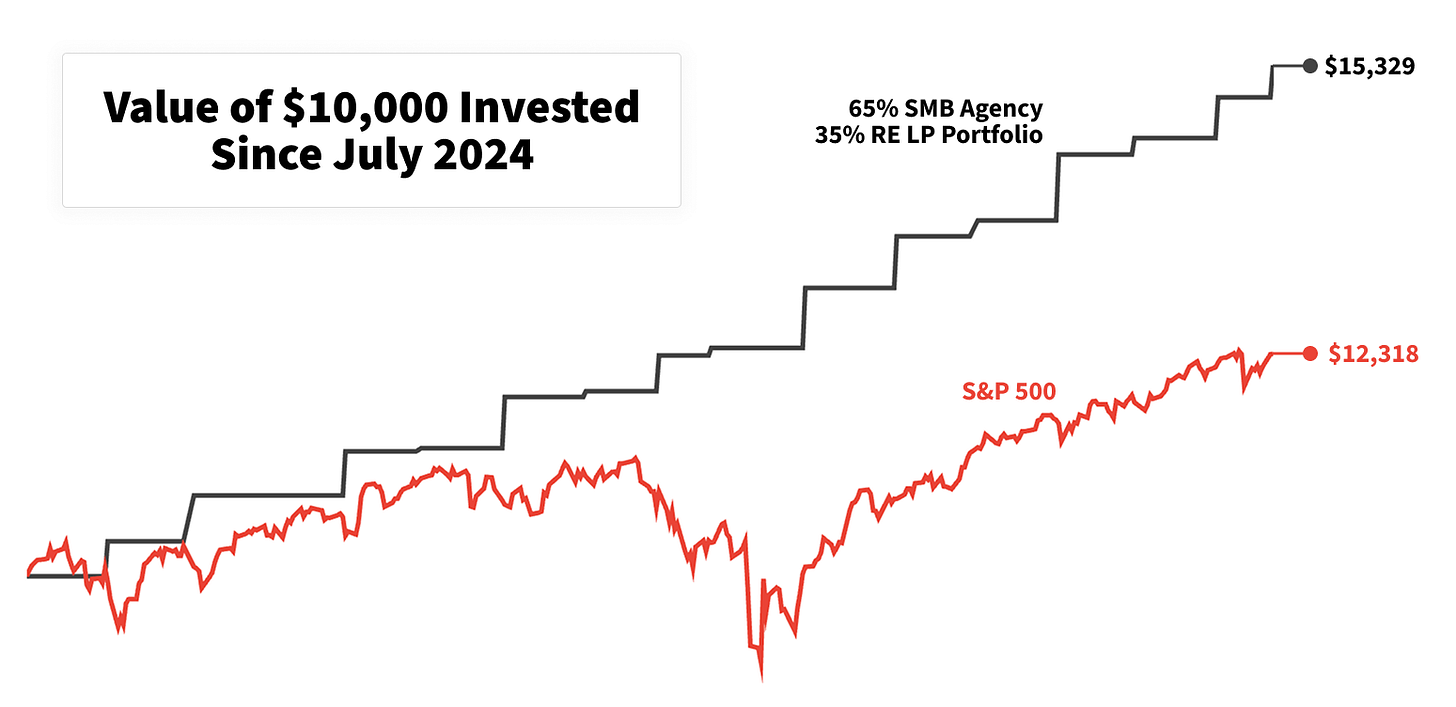Should you buy equity in small services businesses?
Healthy diversification, strong return profile
Over the last few years, we’ve been introducing cash-flowing alternative investments to our portfolio—real estate, small-business private equity, and credit.
Here’s why:
Our thesis is that—at least in the early days—Wilfront will have more cash lying around than we can confidently invest. And since our overall goal is to build torrents of cash flow, it’s natural that we would look for stable, medium-growth sources of cash flow from our portfolio!
By contrast, we are not investing in angel rounds, VC rounds, unprofitable companies of any kind, or any company that intends to have a burn rate in between fundraising rounds. If it doesn’t cash flow, it’s not a fit for us.
Private Portfolio Is Up 40% Annualized vs 17% for S&P500
This is the (actual, not hypothetical) value of one segment of our portfolio that is not invested in SaaS companies. Instead, it’s invested in a small handful of B2B marketing agencies and one private real estate fund. We do not actively manage these investments.
I didn’t even cherry-pick the time period on the comparison, either. This has been a solid period for the United States stock market, despite a temporary dip in Spring 2025.
Unfortunately, You Can’t Just Template This Portfolio
With returns like these and healthy monthly distributions of capital, this “⅓ Real Estate, ⅔ Marketing Agency” portfolio might seem almost perfect.
Well… it is great, but it’s challenging to scale.
If we wanted to scale this, to do it as an investor-backed fund (which we are not and don’t intend to ever be), we’d have to change a lot:
We’d need a LOT more deal flow
We’d need to build a diligence team
We’d need more legal support
We’d need to raise money
We’d need an investor relations department
So we are unlikely to pursue this marketing agency investment model at a significant scale, because we don’t want to do those things (yet).
To be clear, we’re absolutely interested in investing in more B2B companies, including both SaaS and agencies—but investing is not going to be our primary focus. In other words, we can’t become a fund per se.
You just can’t template this stuff. You can’t look at the initial investments we’ve made (not just in this portfolio segment but as a whole) and say, “Great, let’s 10X it”. Not without a serious change in focus.
With each private investment we make, we’ve built a relationship already with the team running the actual company. We have a unique thesis about how our investment partnership (not just capital, but also coaching) will help the company grow.
Can you replicate this?
You might be thinking, “well, if I can’t replicate what you’re doing, what good is this?” Fair, but even if you can’t copy and paste exactly what we’ve done, you can do your own version.
Could you invest a modest amount ($5k, $15k, $25k, $50k, $100k, depending on what that means to you and the company you’re investing in) in someone else’s venture? Did you spend time working in restaurants 10 years ago, and now you have the opportunity to invest in, say, an accounting firm serving restaurants where your friend is becoming a partner soon?
Or let’s say you’re working full-time (with more money than spare development capacity) and your friend is looking for an investor and a second set of eyes for their small SaaS. Maybe they have a pretty straightforward growth playbook that they’d only feel comfortable investing in with just a bit more cash in the bank than they have now, for personal or family financial reasons.
Yet another example might be to become the Fractional CTO of a non-technical services company, one that has a clear idea for a SaaS they want to go to market with. One that you understand and believe in. And you could build it on nights and weekends, in between your day job. Instead of taking cash, you take partnership equity in the business’s LLC structure, valued at a multiple of 3.5X the prior twelve months’ cash flow.
The overall concept is: when you’re investing in an earlier-stage company, the valuation multiples are much lower relative to public markets; but, if you’re familiar with the owner(s) and the industry, you might be okay with or even prefer the increased risk and reward of this investment style, compared to the S&P500.
The challenge for you is to reflect on your relationships more broadly and to be open to the idea of investing in a small business where you can become a partner and positively influence its growth, rather than purely thinking about traditional investments OR venture-style angel investing, with nothing in between. What we’re doing falls into the “in between” category.
How This Fits Our Cash Flow Thesis
At Wildfront, we’re primarily interested in cash-flowing assets. Whether we own and operate them ourselves or invest in companies owned by others. While we appreciate the venture capital industry for bringing a lot of money to the tech industry, and for funding plenty of big bets, each with a low probability of enormous returns… that’s just not our hustle.
So you won’t catch us writing a check in the next hot angel round. And we’re still primarily starting, acquiring, and operating our own products (rather than being full-time investors). But we ARE interested in investing in both SaaS companies and B2B services companies that are profitable and plan to stay so.
Our strategy is to place capital in places where returns can be moderately above the S&P 500 (40-70% per year), but not crazily above it (trying to 200X an initial investment, say).
And then, we sit back and let compounding work its magic.


